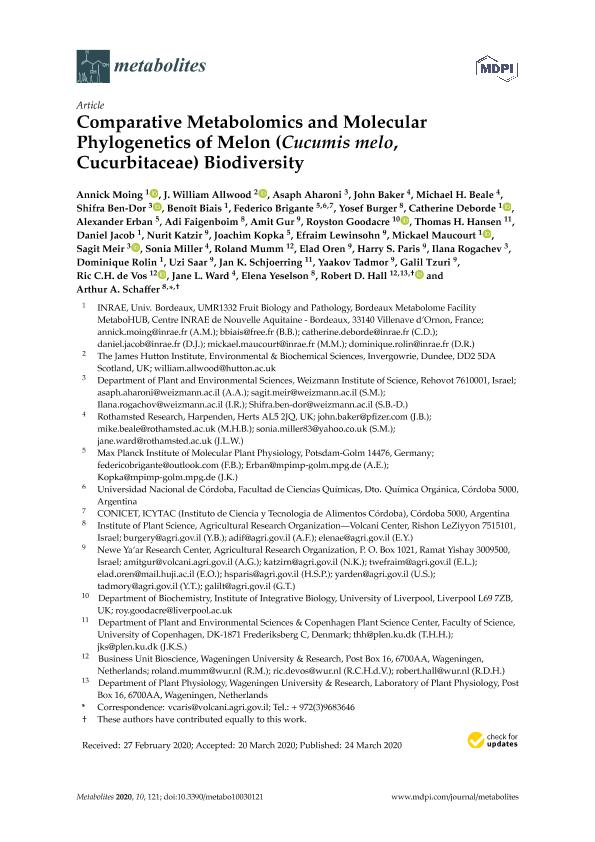Artículo
Comparative metabolomics and molecular phylogenetics of melon (Cucumis melo, cucurbitaceae) biodiversity
Moing, Annick; William Allwood, J.; Aharoni, Asaph; Baker, John; Beale, Michael H.; Ben-Dor, Shifra; Biais, Benoît; Brigante, Federico Iván ; Burger, Yosef; Deborde, Catherine; Erban, Alexander; Faigenboim, Adi; Gur, Amit; Goodacre, Royston; Hansen, Thomas H.; Jacob, Daniel; Katzir, Nurit; Kopka, Joachim; Lewinsohn, Efraim; Maucourt, Mickael; Meir, Sagit; Miller, Sonia; Mumm, Roland; Oren, Elad; Paris, Harry S.; Rogachev, Ilana; Rolin, Dominique; Saar, Uzi; Schjoerring, Jan K.; Tadmor, Yaakov; Tzuri, Galil; de Vos, Ric C. H.; Ward, Jane L.; Yeselson, Elena; Hall, Robert D.; Schaffer, Arthur A.
; Burger, Yosef; Deborde, Catherine; Erban, Alexander; Faigenboim, Adi; Gur, Amit; Goodacre, Royston; Hansen, Thomas H.; Jacob, Daniel; Katzir, Nurit; Kopka, Joachim; Lewinsohn, Efraim; Maucourt, Mickael; Meir, Sagit; Miller, Sonia; Mumm, Roland; Oren, Elad; Paris, Harry S.; Rogachev, Ilana; Rolin, Dominique; Saar, Uzi; Schjoerring, Jan K.; Tadmor, Yaakov; Tzuri, Galil; de Vos, Ric C. H.; Ward, Jane L.; Yeselson, Elena; Hall, Robert D.; Schaffer, Arthur A.
 ; Burger, Yosef; Deborde, Catherine; Erban, Alexander; Faigenboim, Adi; Gur, Amit; Goodacre, Royston; Hansen, Thomas H.; Jacob, Daniel; Katzir, Nurit; Kopka, Joachim; Lewinsohn, Efraim; Maucourt, Mickael; Meir, Sagit; Miller, Sonia; Mumm, Roland; Oren, Elad; Paris, Harry S.; Rogachev, Ilana; Rolin, Dominique; Saar, Uzi; Schjoerring, Jan K.; Tadmor, Yaakov; Tzuri, Galil; de Vos, Ric C. H.; Ward, Jane L.; Yeselson, Elena; Hall, Robert D.; Schaffer, Arthur A.
; Burger, Yosef; Deborde, Catherine; Erban, Alexander; Faigenboim, Adi; Gur, Amit; Goodacre, Royston; Hansen, Thomas H.; Jacob, Daniel; Katzir, Nurit; Kopka, Joachim; Lewinsohn, Efraim; Maucourt, Mickael; Meir, Sagit; Miller, Sonia; Mumm, Roland; Oren, Elad; Paris, Harry S.; Rogachev, Ilana; Rolin, Dominique; Saar, Uzi; Schjoerring, Jan K.; Tadmor, Yaakov; Tzuri, Galil; de Vos, Ric C. H.; Ward, Jane L.; Yeselson, Elena; Hall, Robert D.; Schaffer, Arthur A.
Fecha de publicación:
24/03/2020
Editorial:
MDPI
Revista:
Metabolites
e-ISSN:
2218-1989
Idioma:
Inglés
Tipo de recurso:
Artículo publicado
Clasificación temática:
Resumen
The broad variability of Cucumis melo (melon, Cucurbitaceae) presents a challenge to conventional classification and organization within the species. To shed further light on the infraspecific relationships within C. melo, we compared genotypic and metabolomic similarities among 44 accessions representative of most of the cultivar-groups. Genotyping-by-sequencing (GBS) provided over 20,000 single-nucleotide polymorphisms (SNPs). Metabolomics data of the mature fruit flesh and rind provided over 80,000 metabolomic and elemental features via an orchestra of six complementary metabolomic platforms. These technologies probed polar, semi-polar, and non-polar metabolite fractions as well as a set of mineral elements and included both flavor-and taste-relevant volatile and non-volatile metabolites. Together these results enabled an estimate of “metabolomic/elemental distance” and its correlation with the genetic GBS distance of melon accessions. This study indicates that extensive and non-targeted metabolomics/elemental characterization produced classifications that strongly, but not completely, reflect the current and extensive genetic classification. Certain melon Groups, such as Inodorous, clustered in parallel with the genetic classifications while other genome to metabolome/element associations proved less clear. We suggest that the combined genomic, metabolic, and element data reflect the extensive sexual compatibility among melon accessions and the breeding history that has, for example, targeted metabolic quality traits, such as taste and flavor.
Archivos asociados
Licencia
Identificadores
Colecciones
Articulos(ICYTAC)
Articulos de INST. DE CIENCIA Y TECNOLOGIA DE ALIMENTOS CORDOBA
Articulos de INST. DE CIENCIA Y TECNOLOGIA DE ALIMENTOS CORDOBA
Citación
Moing, Annick; William Allwood, J.; Aharoni, Asaph; Baker, John; Beale, Michael H.; et al.; Comparative metabolomics and molecular phylogenetics of melon (Cucumis melo, cucurbitaceae) biodiversity; MDPI; Metabolites; 10; 3; 24-3-2020; 1-26
Compartir
Altmétricas



